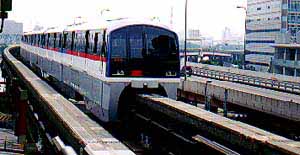Monorails of Japan
|
|
Tokyo-Haneda
If you want the best proof of how monorail can work in transit applications, this is the one! First Proof: Technology. The monorail has operated without flaw since 1964 when it opened in time for the Olympics of that year. It carries people from the Haneda airport to Hamamatsucho Station, which is located on Tokyo's main rail loop. It is a dual rail line in which trains reverse direction each end via switches. To this day many monorail opponents will tell you there are problems with monorail switches. If there were, the Tokyo-Haneda Monorail and many other major monorails could not operate. Second proof; Cost Effectiveness. This monorail is owned and operated by JR. Each year it turns a handsome profit. How many subway or light rail systems turn a profit? Most depend on taxpayer money subsidies, as do roads and highways. Third proof: Operational Experience. As of 2013, over ONE AND A HALF BILLION passengers had ridden the Tokyo-Haneda Monorail. Time and time again we hear it said that monorails aren't proven in transit applications...which is either an amazingly bold lie or a demonstrated ignorance over monorails. Fourth proof: Adaptable to Surrounding Environment. The Tokyo-Haneda line proves that monorail can be built almost anywhere. The tracks begin by parallelling the Shinkansen and city main rail lines. They then cut through heavily developed business and residence areas. Much of the supports are in the canals between the many artificial islands of Tokyo Harbor. At one point, there is a subway segment that runs beneath one of the canals. Stations are built inside buildings, at ground level and in subways beneath Haneda Airport terminals.An extension opened in 2004, with the addition of Terminal Two Station at Haneda Airport. In 2010, a new station opened for Haneda's new International Terminal. Pictured are a Type 1000 train, which was introduced in 1990, and a Type 2000 train introduced in 1997 (photo by Hiroshi Naito). |

